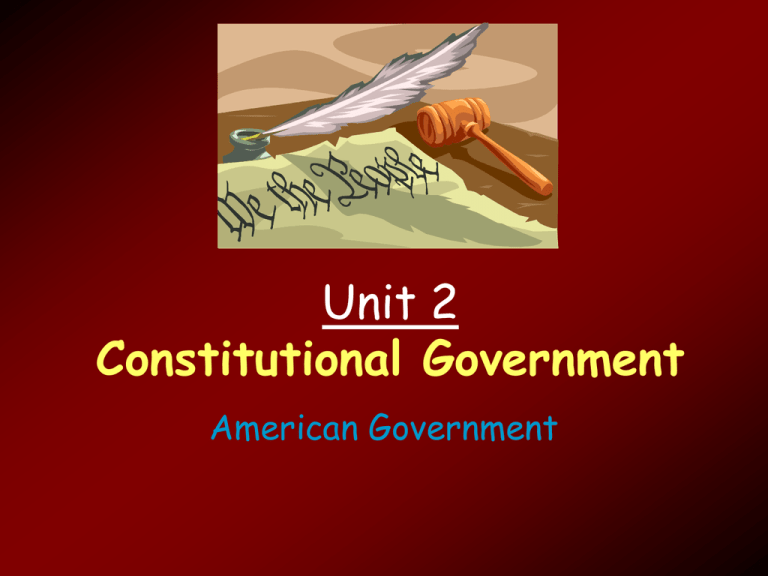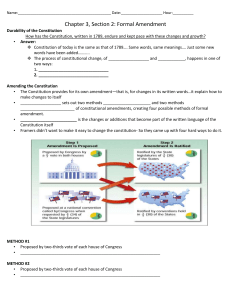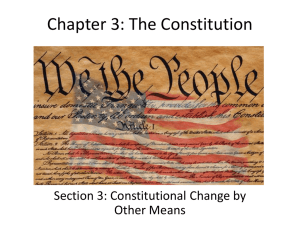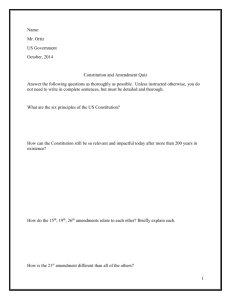Constitution - Paulding County Schools
advertisement

Unit 2 Constitutional Government American Government Factors leading to the Constitutional Convention • • • • Boundary disputes between states Poor foreign relations Unpaid war debts Falling crop prices Constitutional Convention When/Where /Who •September 1787 Why •Articles of Confederation were •Congress met for a not working Constitutional •A stronger central Convention government was needed Constitutional Convention of 1787 • Shay’s Rebellion (1786) caused the framers to believe that the Articles of Confederation were ineffective & needed to be replaced • Delegates gathered in Philadelphia (1787) to “revise” the AOC • James Madison leads the movement to write the Constitution Father of the Constitution Conflict at the Constitutional Convention • Delegates disagreed on THREE key issues: – Representation – Slavery – Trade Conflict @ the Convention: Representation in the new Congress • Big States vs. Small States • Virginia Plan – Representation based upon a states population (favored more populated states) • New Jersey Plan – Each state had equal votes Compromise: Representation • The Great Compromise – Settled the representation conflict – Delegates created a 2 house (bicameral) legislature • One house based upon population (House of Reps) • A second house based upon equal votes per state (the United States Senate) Conflict: The Slavery Issue • Southern states supported slavery – Wanted slaves to count for representation, but not for taxation • Northern states – wanted slaves to count for taxation, not representation Compromise: The Slavery Issue • The Three Fifths Compromise: settles the Slavery Issue – 3 out of 5 slaves would be counted for both representation and taxation Conflict: The Trade Issue • Southern delegates did not want an export or import tax (tariff). • Northern delegates favored a tax on imports to help northern industries grow. This could hurt the South • Compromise: Congress was given the power to tax imports, but not exports The South needed slavery for plantation labor. The North feared slave populations would be to high. Compromise- The importation of slaves would end 20 years from the ratification of the Constitution DEBATE ON RATIFICATION • Federalists argue for a strong federal system to replace the Articles of Confederation (Madison/Hamilton/Jay) • Anti-federalists believe that the new constitution would be too strong and crush the Peoples rights (Henry & S. Adams) The Federalists Papers • Beginning on October 27, 1787 the Federalist Papers were first published in the New York press under the signature of "Publius". • These papers are generally considered to be one of the most important contributions to political thought made in America • The pseudonym "Publius" was used by three man: Jay, Madison and Hamilton. • Jay was responsible for only a few of the 85 articles. • The papers were meant to be influential in the campaign for the adoption of the Constitution by New York State. Compromise: Federalists vs. Anti-federalists • Federalists agree to add a Bill of Rights to the new Constitution • The Addition of the BOR allowed Anti-Feds to agree to ratify the new Constitution • The Constitution was ratified in 1789 Principles Separation of powers with 3 branches of government Checks and balances so that no branch was too powerful Guarantees equality under the law with majority rule and the rights of the minority protected Constitutional Convention They created the U.S. Constitution A written plan for the structure of the U.S. government. Principles Affirms individual worth and dignity of all people Protects the fundamental freedoms of religion, speech, press, assembly, and petition A “living document” About the Constitution • describes the structure of the government and the rights of the American people. • No law may be passed that contradicts its principles • no person, or the government, is exempt from following it. • This is why it is commonly called the "supreme law of the land". The Constitution is organized into three parts: • 1. Preamble describes the purpose of the document and government • 2. Articles establish how the government is structured and how the Constitution can be changed. There are seven articles • 3. Amendments changes to the Constitution; the first ten are called the Bill of Rights Weaknesses of the Articles of Confederation • Unicameral Congress. • No executive branch. • Few powers given to national government. • Congress was elected by the state legislatures. • Congress had no power to regulate trade. • Congress had no power to coin money. • Congress had no power to establish armed forces. Strengths of the Federal Constitution • Bicameral Congress. • President given power to enforce laws. • Congress elected by the people (Senate after Amendment 17) • Simple majority needed to pass laws. • Congress given power to collect taxes. • Congress given power to coin money. • Congress given power to forms army and navy for national defense. FEDERALISM Federalism The division of power between the national government and the governments of the 50 states. Federalism • The powers of government are divided between the national government and the state governments. • The national government governs the people of the entire country • Federal Government- The national government is called the “Federal Government” • The federal government is “the supreme law of the land” that all states must defer to. • Each of the 50 states has its own government. • State governments govern the people living in each state. • Federal System- refers to the country’s system of government including both the national government and the governments of the 50 states. • All powers that the Constitution does not give to the federal government remain with the state governments. Delegated/ Enumerated Powers National Government • Give the federal government strength to protect and serve the country. • • • • -Coin money -Declare war -Admit new states -Establish armed forces • -Regulate patents and copyrights • -Regulate foreign trade Concurrent Powers Both National and State Governments Held by both state and federal governments • • • • -Collect taxes -Enforce laws -Borrow money -Establish courts • -Provide for the general welfare Reserved Powers State Governments Kept for the states to manage their own affairs and to balance the power of the federal government. • • • • • • • • • • -Regulate intrastate commerce (trade) -Conduct elections -Incorporate businesses -Voter qualifications -Establish local governments -Regulate school -Conduct Elections -Establish marriage laws -Assume powers not given to the national government and not denied to the states -Protect the health, safety and welfare of the people. The Preamble The Constitutional Preamble Outlines the goals of the government that it created Goals of the Preamble What it means Where it is found in the Constitution We the people of the United States, in Order to form a more perfect union To create a better government than that provided by the Articles of Confederation By creating a policy making executive branch and by giving Congress the power to tax, the new Constitution avoided the worst difficulties of the Articles of Confederation Goals of the Preamble What it means Where it is found in the Constitution Establish Justice To make laws and establish a fair court system The Constitution created the U.S. Supreme court and the judiciary Act of 1789 created the rest of the federal court system Goals of the Preamble What it means Where it is found in the Constitution Insure Domestic tranquility To maintain law and order at home The federal government shares with state governments the task of maintaining law and order at home. Together they are responsible for enforcing laws. Goals of the Preamble What it means Where it is found in the Constitution Provide for the common defense To protect the nation against its enemies The Constitution authorized Congress to create an army and a navy. Goals of the Preamble Promote the general welfare What it means Where it is found in the Constitution To ensure the Over time, the well being of U.S. government the entire has given all citizens the population right to vote. Goals of the Preamble What it means Where it is found in the Constitution And secure the blessings of liberty to ourselves and to our posterity To safeguard people’s personal freedom The Bill of Rights Goals of the Preamble What it means Do ordain and establish this Constitution for the United States of America. Create this form of government for the country. Where it is found in the Constitution Separation of Powers Separation of Powers Distributes power equally among three branches of government Ensures no person or branch of government is too powerful Legislative Branch • Created in Article I • Congress is the lawmaking branch • Made up of 2 houses: the Senate and the House of Representatives Powers of the Legislative Branch • Makes the laws • Confirms presidential appointments • Approves treaties • Grants money • Declares war Executive Branch • Created in Article II • Executes the country’s laws • Headed by the President Powers of the Executive Branch • Proposes laws • Approves or vetoes laws • Administers and executes the laws • Commands the armed forced • Appoints ambassadors, federal judges and others • Conducts foreign policy • Makes treaties Judicial Branch • Created in Article III • Interprets laws and punishes lawbreakers • Supreme Court is the head of the judicial branch Powers of the Judicial Branch • Interprets the Constitution and other laws • Reviews lower court decisions Checks and Balances •* Each branch has powers that no other branch can have •* Each branch has powers that limit the powers of the other two branches •* Ensures that no branch becomes too powerful Legislative Checks Over The Executive branch • Overrides vetoes • Approves federal judges Over The Judicial branch • Approves federal judges • Impeaches federal judges Executive Checks Over The Legislative branch • Vetoes acts of Congress • Calls Congress into special session Over The Judicial branch • Appoints federal judges Judicial Checks Over The Legislative branch • Declares laws unconstitutional Over The Executive branch • Declares executive acts unconstitutional The Bill of Rights The st 1 Ten Amendments to the Constitution Bill of Rights Why? • 1st Federal Congress wanted a written list of individual rights • To protect against abusive government power. • Influence of other documents (Virginia Statute of Religious Freedom; Virginia Declaration of Rights) What Principle? • Individual Freedoms • Protections against the government • Rights of citizens accused of crimes The First Amendment 5 Protected Freedoms • • • • • Freedom of Speech Freedom of Religion Freedom of the Press Freedom of Assembly Right to petition the government 2nd Amendment Right to bear arms • “A well-regulated militia, being necessary to the security of a free state, the right of the people to bear arms shall not be infringed.” What is the debate with the right to bear arms? • How much can the government keep guns from criminals and youth? • In order to keep guns away from criminals, does that limit the right of law abiding citizens? rd 3 Amendment • The Government cannot force you to shelter soldiers in your home without your consent in time of war or peace. Rights of the Accused Amendments #4-8 Important to preserve freedom th 4 Amendment • What does a policeman need in order to search your home? – A warrant given to him by a judge – Probable cause is also needed th 5 Amendment • You cannot be tried for the same crime twice—called “Double Jeopardy” • You do not have to testify against your self. “I plead the fifth” • You must have due process of law before you are convicted • The government cannot take your land unless it pays. (eminent domain) 6th Amendment • Right to speedy trial by impartial jury—meaning not favoring either side th 6 Amendment • You must be told of charges • You must be provided a lawyer if you cannot afford one th 7 Amendment • Allows a jury trial in Civil Cases when the amount disputed is more than $20. th 8 Amendment • No excessive bail • No cruel and unusual punishment Prisoner kissing his Mom in prison Who determines what the Bill of Rights mean? • The Supreme Court makes rulings on the meaning • The Supreme Court balances the rights of the individual with the needs of society 1st Amendment 5 Freedoms protected by the U.S. Constitution Petition the Government • “Congress shall make no law . . . Abridging . . . the people. . . to petition the government for a redress of grievances” Petition • Freedom to make views known to public officials • Grievance with government policy Petition the government • You may sue the government for wrongs • You cannot be punished for exposing wrongs by the government • The courts decide the wrongs Freedom of Religion • “Congress shall make no law respecting an establishment of religion or prohibiting the free exercise there of” Religion • Freedom to exercise religion • Government can’t establish an official religion • Government can’t endorse a religion Free Exercise— The person Can Cannot • Choose whatever religion • Lead a prayer in most examples • Ask questions about religions • Worship whoever or whatever you want • Break the law and claim it is religious belief • Raise children without education • Deprave children of basic needs Establishment clause-Government CAN CAN NOT • Teach about religions in school • Allow voluntary prayer in many examples • Transport students to a religious school • Read Bible for culture or literacy content • Set a state religion • Government cannot order a prayer • Teach religious doctrine in the school • Pay seminary teachers • Teach creationism Freedom of Assembly • Congress shall make no law . . . Abridging . . . The people to peaceably assemble” Assembly • Freedom to gather peacefully • Political rally • Protest march • Sit in Freedom of Assembly– The Individual CAN CANNOT • Protest • Parade (with a permit) • Parade chanting hate slogans • Gang members can congregate in public • Protest by throwing rocks and breaking windows • Hang out on private land against owners will—loitering • Break teen curfew Freedom of Speech • “Congress shall make no laws . . . abridging the freedom of speech” Speech • Freedom to express opinions and beliefs • Not absolute • Obscenity is not protected Free speech– The individual can: • • • • • • Say any political belief Protest (without getting out of control) Say things about someone that are true Burn the flag Say racist and hate slogans Free speech means someone might say something you disagree with Free speech— A person CANNOT • Threaten to blow up airplanes, schools or the president • Sexual harassment • Create too much social chaos • Extremely crude language in a public form • Disrespectful, vulgar language in schools • Hate crimes Freedom of the Press • Congress shall make no law . . . abridging . . . the freedom of the press.” Press • Freedom to gather and publish information • Freedom to criticize the government Freedom of the press- The press CAN CANNOT • Print any political position • Make fun of people, especially politicians • Expose wrongs by the government • Say things you might not agree with • Libel– intentionally injuring a person’s reputation by false facts • Disclose defensesecurity secrets • Detail how to make a certain weapons The Constitution establishes and protects our 1st Amendment freedoms, but there are limits!! Constitutional Amendments A “Living Document” The framers of the Constitution planned a system of government that could adapt to the changing conditions and needs of the country. The Constitution is called a living document because it can be changed. A Living Document Adaptability- Amendments • An amendment is a written change to the Constitution. • The amendment process is complex; to date only 27 amendments have been added. • The first 10 amendments are called “The Bill of Rights.” Flexibility- Elastic Clause • Also known as the “necessary and proper clause • ”Allows Congress to extend its delegated powers.“to make all laws which shall be necessary and proper for carrying into execution the foregoing powers” • Permits Congress to pass laws related to situations that have developed since the writing of the Constitution. Process for Amending the Constitution • Action by Congress or Convention (2/3 of Congress) • Ratification by the states (3/4 of States) Eleventh Amendment (1795) Clarifies judicial power over foreign nationals, and limits ability of citizens to sue states in federal courts and under federal law. Twelfth Amendment (1804) Changes the method of presidential elections so that members of the electoral college cast separate ballots for president and vice president Thirteenth Amendment (1865) Abolishes slavery and grants Congress power to enforce abolition. Fourteenth Amendment (1868): Defines United States citizenship; prohibits states from abridging citizens' privileges or immunities and right to due process and the equal protection of the law; repeals the three-fifths compromise. Fifteenth Amendment (1870) Prohibits the federal government and the states from using a citizen's race, color, or previous status as a slave as a qualification for voting. Sixteenth Amendment (1913) Authorizes unapportioned federal taxes on income. Seventeenth Amendment (1913) Establishes direct election of senators. Eighteenth Amendment (1919) Prohibited the manufacturing, importing, and exporting of beverage alcohol. Repealed by the TwentyFirst Amendment. Nineteenth Amendment (1920) Prohibits the federal government and the states from using a citizen's sex as a qualification for voting Twentieth Amendment (1933) Changes details of Congressional and presidential terms and of presidential succession. Twenty-first Amendment (1933) Repeals Eighteenth Amendment but permits states to retain prohibition and ban the importation of alcohol. Twenty-second Amendment (1951) Limits president to two terms. Twenty-third Amendment (1961) Grants presidential electors to the District of Columbia. Twenty-fourth Amendment (1964) Prohibits the federal government and the states from requiring the payment of a tax as a qualification for voting for federal officials. Twenty-fifth Amendment (1967) Changes details of presidential succession, provides for temporary removal of president, and provides for replacement of the vice president. Twenty-sixth Amendment (1971) Prohibits the federal government and the states from using an age greater than 18 as a qualification to vote. Twenty-seventh Amendment (1992) Limits congressional pay raises.








